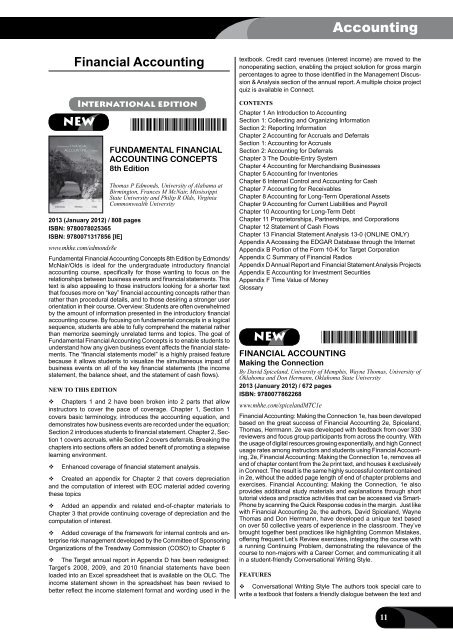Download - McGraw-Hill Books
Download - McGraw-Hill Books
Download - McGraw-Hill Books
- No tags were found...
You also want an ePaper? Increase the reach of your titles
YUMPU automatically turns print PDFs into web optimized ePapers that Google loves.
AccountingFinancial AccountingInternational editionNEW*9780078025365*2013 (January 2012) / 808 pagesISBN: 9780078025365ISBN: 9780071317856 [IE]www.mhhe.com/edmonds8eFUNDAMENTAL FINANCIALACCOUNTING CONCEPTS8th EditionThomas P Edmonds, University of Alabama atBirmington, Frances M McNair, MississippiState University and Philip R Olds, VirginiaCommonwealth UniversityFundamental Financial Accounting Concepts 8th Edition by Edmonds/McNair/Olds is ideal for the undergraduate introductory financialaccounting course, specifically for those wanting to focus on therelationships between business events and financial statements. Thistext is also appealing to those instructors looking for a shorter textthat focuses more on “key” financial accounting concepts rather thanrather than procedural details, and to those desiring a stronger userorientation in their course. Overview: Students are often overwhelmedby the amount of information presented in the introductory financialaccounting course. By focusing on fundamental concepts in a logicalsequence, students are able to fully comprehend the material ratherthan memorize seemingly unrelated terms and topics. The goal ofFundamental Financial Accounting Concepts is to enable students tounderstand how any given business event affects the financial statements.The “financial statements model” is a highly praised featurebecause it allows students to visualize the simultaneous impact ofbusiness events on all of the key financial statements (the incomestatement, the balance sheet, and the statement of cash flows).NEW TO THIS EDITIONChapters 1 and 2 have been broken into 2 parts that allowinstructors to cover the pace of coverage. Chapter 1, Section 1covers basic terminology, introduces the accounting equation, anddemonstrates how business events are recorded under the equation;Section 2 introduces students to financial statement. Chapter 2, Section1 covers accruals, while Section 2 covers deferrals. Breaking thechapters into sections offers an added benefit of promoting a stepwiselearning environment.Enhanced coverage of financial statement analysis.Created an appendix for Chapter 2 that covers depreciationand the computation of interest with EOC material added coveringthese topicsAdded an appendix and related end-of-chapter materials toChapter 3 that provide continuing coverage of depreciation and thecomputation of interest.Added coverage of the framework for internal controls and enterpriserisk management developed by the Committee of SponsoringOrganizations of the Treadway Commission (COSO) to Chapter 6The Target annual report in Appendix D has been redesigned:Target’s 2008, 2009, and 2010 financial statements have beenloaded into an Excel spreadsheet that is available on the OLC. Theincome statement shown in the spreadsheet has been revised tobetter reflect the income statement format and wording used in thetextbook. Credit card revenues (interest income) are moved to thenonoperating section, enabling the project solution for gross marginpercentages to agree to those identified in the Management Discussion& Analysis section of the annual report. A multiple choice projectquiz is available in Connect.ContentsChapter 1 An Introduction to AccountingSection 1: Collecting and Organizing InformationSection 2: Reporting InformationChapter 2 Accounting for Accruals and DeferralsSection 1: Accounting for AccrualsSection 2: Accounting for DeferralsChapter 3 The Double-Entry SystemChapter 4 Accounting for Merchandising BusinessesChapter 5 Accounting for InventoriesChapter 6 Internal Control and Accounting for CashChapter 7 Accounting for ReceivablesChapter 8 Accounting for Long-Term Operational AssetsChapter 9 Accounting for Current Liabilities and PayrollChapter 10 Accounting for Long-Term DebtChapter 11 Proprietorships, Partnerships, and CorporationsChapter 12 Statement of Cash FlowsChapter 13 Financial Statement Analysis 13-0 (ONLINE ONLY)Appendix A Accessing the EDGAR Database through the InternetAppendix B Portion of the Form 10-K for Target CorporationAppendix C Summary of Financial RadiosAppendix D Annual Report and Financial Statement Analysis ProjectsAppendix E Accounting for Investment SecuritiesAppendix F Time Value of MoneyGlossaryNEW *9780077862268*FINANCIAL ACCOUNTINGMaking the ConnectionBy David Spiceland, University of Memphis, Wayne Thomas, University ofOklahoma and Don Hermann, Oklahoma State University2013 (January 2012) / 672 pagesISBN: 9780077862268www.mhhe.com/spicelandMTC1eFinancial Accounting: Making the Connection 1e, has been developedbased on the great success of Financial Accounting 2e, Spiceland,Thomas, Herrmann. 2e was developed with feedback from over 330reviewers and focus group participants from across the country. Withthe usage of digital resources growing exponentially, and high Connectusage rates among instructors and students using Financial Accounting,2e, Financial Accounting: Making the Connection 1e, removes allend of chapter content from the 2e print text, and houses it exclusivelyin Connect. The result is the same highly successful content containedin 2e, without the added page length of end of chapter problems andexercises. Financial Accounting: Making the Connection, 1e alsoprovides additional study materials and explanations through shorttutorial videos and practice activities that can be accessed via Smart-Phone by scanning the Quick Response codes in the margin. Just likewith Financial Accounting 2e, the authors, David Spiceland, WayneThomas and Don Herrmann, have developed a unique text basedon over 50 collective years of experience in the classroom. They’vebrought together best practices like highlighting Common Mistakes,offering frequent Let’s Review exercises, integrating the course witha running Continuing Problem, demonstrating the relevance of thecourse to non-majors with a Career Corner, and communicating it allin a student-friendly Conversational Writing Style.FEATURESConversational Writing Style The authors took special care towrite a textbook that fosters a friendly dialogue between the text and11
















